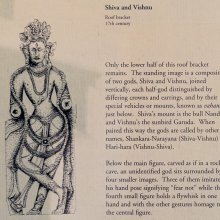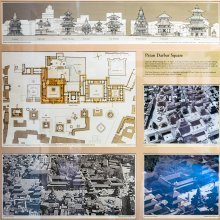Shankaranarayana, Śaṃkaranārāyaṇa, Śaṅkaranārāyaṇa, Shamkara-narayana, Shamkaranarayana, Shankara-narayana: 4 definitions
Introduction:
Shankaranarayana means something in Hinduism, Sanskrit, the history of ancient India. If you want to know the exact meaning, history, etymology or English translation of this term then check out the descriptions on this page. Add your comment or reference to a book if you want to contribute to this summary article.
The Sanskrit terms Śaṃkaranārāyaṇa and Śaṅkaranārāyaṇa can be transliterated into English as Samkaranarayana or Shamkaranarayana or Sankaranarayana or Shankaranarayana, using the IAST transliteration scheme (?).
Images (photo gallery)
In Hinduism
Shilpashastra (iconography)
Source: Archaeological Survey of India: Śaiva monuments at Paṭṭadakal (śilpa)Śaṅkaranārāyaṇa (शङ्करनारायण) is a sculpture found at the temple of Vijayeśvara, at the southern side, western niche.—By and large this kind of image is called Harihara. But we prefer to term it as Śaṅkara-Nārāyaṇa because, when we read the image, Śiva is to the right and Viṣṇu to the left of the same icon. As the image is rough, probably unfinished, the emblem in Śiva’s right upper hand is not clear and the lower is resting on his lap. The conch held in the left hand of the image helps us to identify the image.

Shilpashastra (शिल्पशास्त्र, śilpaśāstra) represents the ancient Indian science (shastra) of creative arts (shilpa) such as sculpture, iconography and painting. Closely related to Vastushastra (architecture), they often share the same literature.
India history and geography
Source: archive.org: Studies In Indian Literary HistoryŚaṃkaranārāyaṇa (शंकरनारायण) is the name of a South-Indian Tirtha (sacred place) mentioned in the Gīrvāṇapadamañjarī authored by Varadarāja (A.D. 1600-1650), a pupil of Bhaṭṭoji Dīkṣita.—Varadarāja in his Gīrvāṇapadamañjarī refers to several works which ought to be studied by a Pandit. In the same text are listed some Ghats of Benares (Varanasi). We also find in this work a list of holy places or tīrthas on folio 6 of the manuscript [e.g., śaṃkaranārāyaṇa-kṣetra] which appears to have been composed say between A.D. 1600 and 1650.—[Cf. the manuscript of the Gīrvāṇapadamañjarī at the Government Manuscripts Library, B.O.R. = Bhandarkar Oriental Research Institute, Poona]

The history of India traces the identification of countries, villages, towns and other regions of India, as well as mythology, zoology, royal dynasties, rulers, tribes, local festivities and traditions and regional languages. Ancient India enjoyed religious freedom and encourages the path of Dharma, a concept common to Buddhism, Hinduism, and Jainism.
Languages of India and abroad
Sanskrit dictionary
Source: Cologne Digital Sanskrit Dictionaries: Aufrecht Catalogus CatalogorumŚaṅkaranārāyaṇa (शङ्करनारायण) as mentioned in Aufrecht’s Catalogus Catalogorum:—Rasikāmṛta nāṭaka.
Source: Cologne Digital Sanskrit Dictionaries: Monier-Williams Sanskrit-English DictionaryŚaṃkaranārāyaṇa (शंकरनारायण):—[=śaṃkara-nārāyaṇa] [from śaṃkara > śam] m. Viṣṇu-Śiva (= hari-hara), [Religious Thought and Life in India 65]
Sanskrit, also spelled संस्कृतम् (saṃskṛtam), is an ancient language of India commonly seen as the grandmother of the Indo-European language family (even English!). Closely allied with Prakrit and Pali, Sanskrit is more exhaustive in both grammar and terms and has the most extensive collection of literature in the world, greatly surpassing its sister-languages Greek and Latin.
See also (Relevant definitions)
Partial matches: Shankara, Narayana, Camkara.
Starts with: Shamkaranarayanakshetra, Shankaranarayanamahatmya, Shankaranarayanashtottarashata.
Query error!
Full-text: Shamkaranarayanamahatmya, Shankaranarayanamahatmya, Shamkaranarayanakshetra, Shamkaranarayanashtottarashata, Rasikamrita, Harihara, Govindaswami, Bhaskara, Mahesha, Ardhanarishvara.
Relevant text
Search found 23 books and stories containing Shankaranarayana, Śaṃkara-nārāyaṇa, Samkara-narayana, Śaṃkaranārāyaṇa, Samkaranarayana, Sankara-narayana, Śaṅkara-nārāyaṇa, Śaṅkaranārāyaṇa, Sankaranarayana, Shamkara-narayana, Shamkaranarayana, Shankara-narayana; (plurals include: Shankaranarayanas, nārāyaṇas, narayanas, Śaṃkaranārāyaṇas, Samkaranarayanas, Śaṅkaranārāyaṇas, Sankaranarayanas, Shamkaranarayanas). You can also click to the full overview containing English textual excerpts. Below are direct links for the most relevant articles:
Sanskrit sources of Kerala history (by Suma Parappattoli)
3. The Laghubhaskariya-Vivarana < [Chapter 6 - Miscellaneous Sanskrit works bearing on Kerala history]
1.4. The 64 Villages in Kerala Mahatmya < [Chapter 2 - Historical details from Mahatmyas and Prashastis]
Isanasivagurudeva Paddhati (study) (by J. P. Prajith)
3. The Supremacy of Lord Siva in Isanasivagurudeva-paddhati < [Chapter 3 - Depiction of Gods and Goddesses]
2. Important deities in Isanasivagurudeva-paddhati < [Chapter 3 - Depiction of Gods and Goddesses]
10. Summary of the Yoga-pada of the Isanasivagurudeva-paddhati < [Chapter 2 - A Textual analysis]
Prayogamanjari and Saivagamanibandhana (Study) (by R. Suthashi)
Silparatna of Srikumara (summary) < [Chapter 1 - Introduction]
Tantrasamuccaya (summary) < [Chapter 1 - Introduction]
Talabheda—Different measurements < [Chapter 3 - Shaiva iconography in Saivagamanibandhana]
World Journal of Pharmaceutical Research
Phytochemistry and pharmacology of santalum album l. < [2015: Volume 4, October issue 10]
Role of Euphorbia hirta phytoconstituents in disease prevention < [2015: Volume 4, July issue 7]
Effect of Michelia champaca on stress-induced behavior in rats. < [2015: Volume 4, July issue 7]
Notices of Sanskrit Manuscripts (by Rajendralala Mitra)
Page 186 < [Volume 6 (1882)]
Yoga-sutra with Bhashya Vivarana (study) (by Susmi Sabu)
Sankara Bhagavatpada as the author < [Chapter 3 - The Authorship Problem of Patanjala-yogasutra-bhashya-vivarana]
Related products


